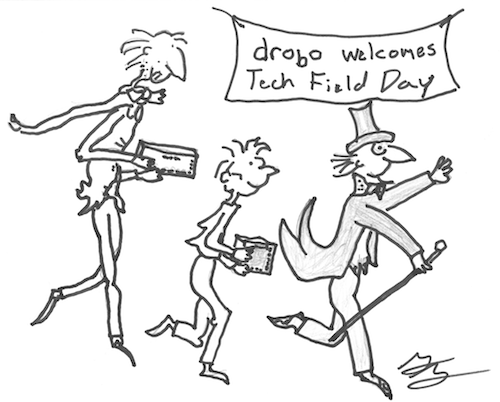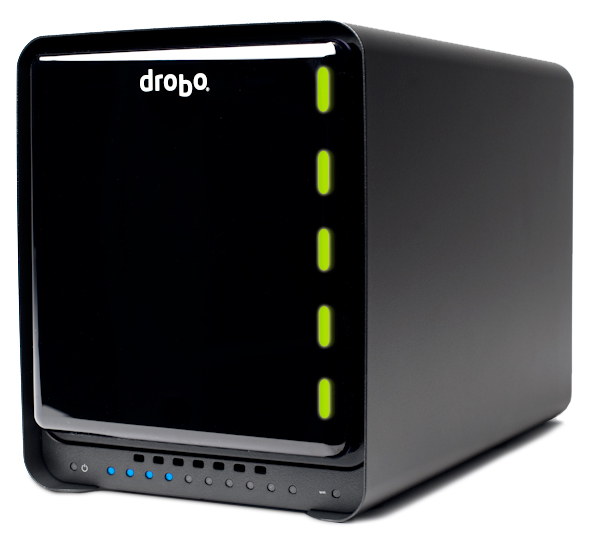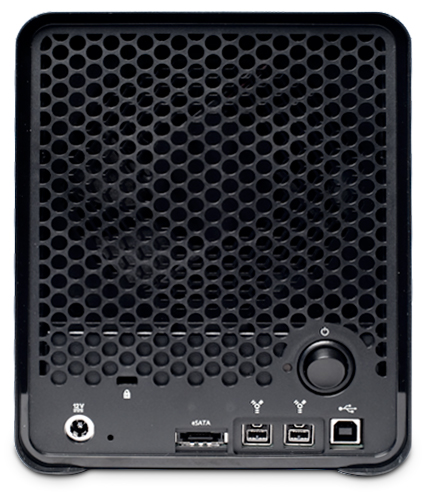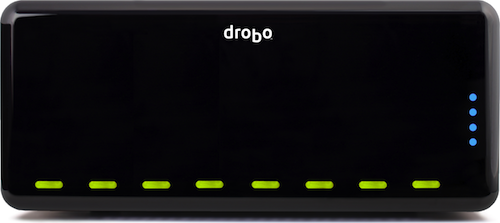
“Greetings to you,” said the invitation. “I shake you warmly by the hand!” So began the famous journey of Charlie and the Chocolate Factory. The same note might as well have been used when the delegates selected to attend Gestalt IT‘s Tech Field Day got to visit the Data Robotics chocolate factory. This littlest storage company has become the darling of techies, and they opened their doors to 15 lucky bloggers, giving a sneak peek at what everyone can see for themselves today, the Drobo S and DroboElite.
What’s the news? Data Robotics has doubled the size of their product line, adding two new Drobo storage devices alongside the existing Drobo (version 2) and DroboPro, which I’ve previously written about. There was much speculation about what Data Robotics would do next: Would they push the envelope with a big 20-drive unit or a tiny 2.5″ array?
Stephen Foskett unveils the DroboElite and Drobo S from Stephen Foskett on Vimeo.
Instead, Data Robotics followed the lead of Willy Wonka’s great glass elevator, taking their existing small- and mid-sized Drobo and DroboPro in alternative directions:
- The Drobo S focuses on desktop performance, with an additional drive slot, eSATA, and faster internals
- The DroboElite is intended for small SANs and virtualization, with a (nearly) full iSCSI implementation
The existing second-generation Drobo and DroboPro continue, focusing on single-computer connectivity and ease of use.
Drobo S: High-Performance Desktop Storage

In photos, the new Drobo S looks a lot like the existing (and continuing) 4-drive Drobo unit. But it has a distinctly different look in person, with its curving metal bezel and taller stance. Indeed, the Drobo S looks almost un-Drobo-like: A little tougher and meaner than the cuddly rounded devices Data Robotics is known for.
Under the skin, however, the Drobo S is entirely new. Although Data Robotics isn’t giving specifics, they do claim at least a 50% bump in performance compared to the existing Drobo. I suspect that a new CPU and additional cache RAM is the source of this improvement. The extra drive slot is bound to help, too, since Drobo will stripe data across all available drives. As we all know, the first place storage companies look for performance is disk drive spindles!
That extra disk slot gives the Drobo S another important benefit: With dual parity operation, the Drobo S can protect against the simultaneous failure of two drives! Drobo added this capability to the 8-drive DroboPro earlier this year, but the 4-drive desktop unit still relies on single parity. Perhaps it lacks the CPU power required to support dual parity, or maybe it is artificially limited due to the fact that a 4-drive dual-parity Drobo would suffer a 50% capacity hit. Regardless, those wishing for enhanced data protection as well as improved performance can now step up to a Drobo S.
I am personally very pleased to see dual-drive redundancy come to a desktop Drobo. One of the things I love about my Drobo is the fact that my data is protected so well: If a disk drive fails (and they do fail often) I can slap in a new one and not lose anything. My one complaint is that there is no safe way to eject a drive from a Drobo: If you want to move from a 500 GB to a 1.5 TB drive, you just pop the drive out live and let Drobo handle the heavy lifting required to re-protect the data. Since this process leaves the drives working hard for hours, the risk of data loss increases to a level I find unacceptable. Dual-drive protection is an absolute requirement for irreplaceable data, and I am thankful that this is supported on the Drobo S, DroboPro, and DroboElite. I wish Data Robotics would implement a “data flush” feature on the Drobo, allowing me to tell the unit ahead of time to safely clear the content of a drive to be removed.

Although the desktop Drobo does not exactly push the performance limits of FireWire 800 (you would be lucky to get 50 MB/s throughput from a 4-drive Drobo), the Drobo S adds eSATA connectivity. I suspect that switching from USB or FireWire to eSATA will have little real-world performance impact, but it does open the intriguing possibility of an 8 TB TiVo! Mac users won’t notice this feature, however, since Uncle Steve refuses to equip Macs with eSATA ports.
It is important to reiterate that, although the Drobo S now features four data ports on the rear of the unit, only one port may be used at a time. Only the DroboElite (see below) is suitable for direct use by more than one computer. Capacity from the others can be shared as SMB, NFS, or AFP drives, but only if an appropriate intermediary (such as a DroboShare, Mac, or PC) is used. Let me be very clear here: You can choose either USB, FireWire, or (for the Drobo S) eSATA, but you cannot use all three at once. And that second FireWire port is only used to daisy-chain devices with which the Drobo can not and will not interact. Drobo is intended to be a simple direct-attached storage device, not an a networked storage server like the Iomega ix4.
Then there is pricing. The base Drobo price was reduced to US$399 earlier this year, and rebates and specials can drop that price much lower. I purchased my Drobo for just US$282, leveraging a discount, a rebate, and Bing Cashback. For all you get, Drobo is a killer value and I heartily recommend it to everyone with precious data to preserve. It’s also an investment, since Drobo remains the only storage device that can seamlessly add and upgrade the storage capacity on a drive-by-drive basis as needed.
The Drobo S starts at US$799, a price many may see as too high. Feature-wise, Drobo S is very similar to the base Drobo, with eSATA and dual-parity being the only main differentiators. But real-world use might justify this higher price: The added performance makes Drobo S a viable primary storage device for demanding applications like video editing, an activity that the base Drobo is not quite as capable at. I expect sales of the Drobo S to be somewhat slower than the base unit, but they will likely be strong in the “creative professional” market, where the added speed is a requirement. I also expect much whining and moaning over the price from the cheapskate fanboys in the audience!
In summary, the Drobo S is an excellent addition to the family, but not a slam dunk. Drobo S is a slantways upgrade, and I wonder if the additional performance and data protection will seem to be worth twice the price to prospective buyers. If anything, the Drobo S might promote sales of the cheaper base model Drobo!
DroboElite: A Real iSCSI SAN At Last!

Drobos are like Apple Macs: As cool as they are, they never really seem all that business oriented. Simple, friendly, and functional are great attributes, but business use demands compatibility, flexibility, and support. DroboPro, with its rack-mount kit and iSCSI support, was definitely a gesture at the business world, but it was frustratingly limited to single-server duty.
All that changes today. DroboElite delivers nearly everything a small business could want from a computer closet storage device. It is a real honest-to-goodness iSCSI SAN array, supporting multiple servers and sporting dual gigabit Ethernet ports and dual-drive data protection. Data Robotics also claims VMware ESX certification, though the DroboElite does not yet appear on the VMware SAN support list.
So what separates the DroboElite from the similar-looking 8-drive DroboPro?
- The DroboElite is the first Drobo to support multiple connected servers (via iSCSI)
- One can now provision up to 255 Smart Volumes and these are protected with LUN masking
- The DroboElite sports internal improvements to make it “at least 50% faster”
- DroboElite gets an additional gigabit Ethernet port for iSCSI
Both the DroboPro and DroboElite share a similar 8-drive chassis and rack-mount kit, and both support dual-drive data protection. And of course, every Drobo sports Data Robotics’ unique BeyondRAID technology, allowing seamless live expansion and upgrades as well as thin provisioning.
All of these improvements make DroboElite the first Drobo to be truly business-ready. A single DroboElite can share storage volumes over gigabit Ethernet to one or a dozen servers. These can be PCs running Windows or Linux, Macs running OS X, or VMware ESX servers, each of which would enjoy the benefits of thin provisioned storage capacity. These volumes appear as large direct-attached hard disk drives using iSCSI initiator software available for all four operating systems, and the DroboElite will protect them to keep misbehaving servers from stomping on the storage of others.
Users of VMware ESX will especially enjoy the flexibility of thin provisioning and multiple iSCSI volumes. DroboElite supports both VMFS and RDM over iSCSI, both of which are supported by Drobo’s thin provisioning and un-provisioning. That last is key: All Drobo devices “spy” on supported partition schemes and filesystems, reclaiming space as files are deleted!
There are some limitations, however. Non-thin VMDK images “nested” in VMFS are not thin provisioned by Drobo either: It sees the entire allocated size as being used. Although the additional gigabit Ethernet port is a welcome addition, it does not support HA (active/passive or active/active) configuration. Finally, the DroboElite (like nearly all other low-end iSCSI arrays) does not yet support SCSI3 persistent reservation so it is not suitable for Windows clustering.
Most smaller businesses fall well within these limits, however. Unlike the DroboPro, which is really only suitable for single-computer use, the DroboElite promises to be everything most small and even medium-sized businesses need in a storage system: Inexpensive, reliable, flexible, simple to install and manage, and performant enough for operational use. The DroboElite joins the Drobo on my short list of recommended products: Every home and business user should have flexible and reliable data storage, and the Drobo and DroboElite fit the bill perfectly.
Up and Out!
So did Drobo blow the roof off of the storage market? Not really. Like Willy Wonka or the House of Jobs, Drobo can be hard to comprehend for outsiders. Drobo storage systems are more expensive than seemingly-similar devices from other vendors and lack many of the features listed on their boxes. And this new product rollout does not stray far from that formula. Indeed, many will likely find it difficult to differentiate the four-Drobo product lineup.
But believers in simplicity (oh heck, let’s just call them “Mac users”) will love what Data Robotics is doing. Compulsively-complete feature lists terrify them as much on a storage system as on a Microsoft package, and are just about as useful. Rather than doing everything, Drobo focuses on doing what’s needed simply, cleanly, and unobtrusively. It’s ironic that some of the most elegantly-designed hardware I own (the Mac Mini and Drobo) simply disappear on my desk. But they do their work and let me do mine. What else could I want?
To those in the know, Data Robotics is becoming as much an admired company as Apple, and for similar reasons. This explains the “golden ticket” atmosphere of the Gestalt IT Tech Field Day, as well as resulting videos like this one, from Rod Haywood. Sounds like success to me!
Drobo configuration by a 12 year old from Rodney Haywood on Vimeo.
Drobo is most definitely marching on. I agree with the simplicity ideology. I really don’t want my storage device downloading torrents or running an iTunes server. I just want it to store my data reliably and produce it quickly. Doesn’t the Drobo Elite have new features to prevent data corruption as well? Right now the Drobo S or Elite (depending on need an/or budget) looks like the perfect mass storage for the Mac mini server. I imagine that in a few years we may even see a Light Peak version of the Drobo and I’ll be able to store my storage away in a cool and safe place and no one will know I have 12+ Terabytes of data sitting on the other end of a fiber optic cable.
As a note for those looking at the VMware Compatibility Guide; it doesn’t seem to find the DroboPro (only one on there at this time) by name, but you can select ‘Data Robotics Inc.’ from the ‘Partner Name’ pop up, which will show you an entry for the ‘DRPR1-A’. This is the DroboPro; as the Elite gets certified it should show up there as well.
Also of note; if implemented with VMware ESX servers, the DroboPro supports up to four (4) servers, with two being the recommended limit. See the Data Robotics’ VMware briefs and such, they have a good chunk of detail.
As a note for those looking at the VMware Compatibility Guide; it doesn't seem to find the DroboPro (only one on there at this time) by name, but you can select 'Data Robotics Inc.' from the 'Partner Name' pop up, which will show you an entry for the 'DRPR1-A'. This is the DroboPro; as the Elite gets certified it should show up there as well.
Also of note; if implemented with VMware ESX servers, the DroboPro supports up to four (4) servers, with two being the recommended limit. See the Data Robotics' VMware briefs and such, they have a good chunk of detail.
As a note for those looking at the VMware Compatibility Guide; it doesn’t seem to find the DroboPro (only one on there at this time) by name, but you can select ‘Data Robotics Inc.’ from the ‘Partner Name’ pop up, which will show you an entry for the ‘DRPR1-A’. This is the DroboPro; as the Elite gets certified it should show up there as well.
Also of note; if implemented with VMware ESX servers, the DroboPro supports up to four (4) servers, with two being the recommended limit. See the Data Robotics’ VMware briefs and such, they have a good chunk of detail.
As a note for those looking at the VMware Compatibility Guide; it doesn't seem to find the DroboPro (only one on there at this time) by name, but you can select 'Data Robotics Inc.' from the 'Partner Name' pop up, which will show you an entry for the 'DRPR1-A'. This is the DroboPro; as the Elite gets certified it should show up there as well.
Also of note; if implemented with VMware ESX servers, the DroboPro supports up to four (4) servers, with two being the recommended limit. See the Data Robotics' VMware briefs and such, they have a good chunk of detail.
I do like the direction Drobo is heading, and it truly is getting better. But they cannot, and I repeat, CANNOT sell themself as enterprise until they put in redundant power supplies. I will not run my VM environment on a storage solution that has any single point of failure.
I really was hoping to see this improvement come after they pushed the Drobo Pro to me as ‘Enterprise’. I relayed my conern on the lack of redundant power supplies to their engineer, and he really just blew me off as if it truly isn’t a big deal. I figured they would really think about that and in the next release fix this major flaw. Still waiting I guess.
Thanks for the great summary on the new droobs! I’m torn between buying a G-Technology raid (focusing on performance) and the Drobo S (focusing on flexibility/upgradeability). You’re post was very informative, but I’m still no closer to making a decision. 🙂 I do want to add however that Mac users with towers (Macpro, etc.) or laptops with express slots can add eSata connectivity rather easily. It is frustrating that Papa Jobs won’t give us eSata standard.